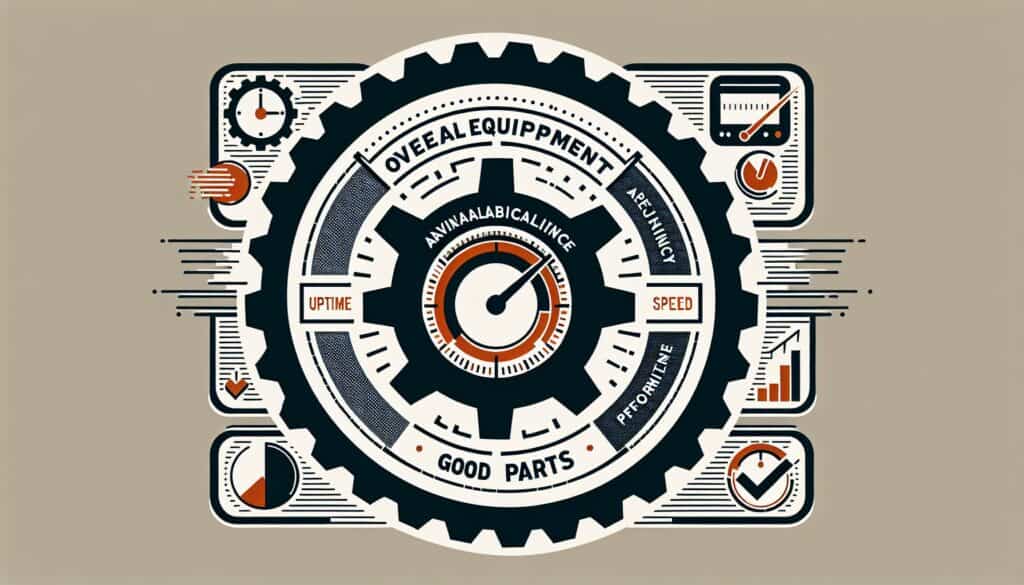A key performance indicator that measures manufacturing productivity by combining three factors: Availability (uptime), Performance (speed), and Quality (good parts).
- Metodologías: Ergonomía
OEE (Eficacia global de los equipos)

OEE (Eficacia global de los equipos)
- Mejora continua, Indicador clave de rendimiento (KPI), Manufactura esbelta, Eficacia global de los equipos (OEE), Seguimiento del rendimiento, Mejora de procesos, Productivity, Gestión de calidad
Objetivo:
Cómo se utiliza:
- Calculated as: OEE = Availability x Performance x Quality. Availability accounts for downtime losses. Performance accounts for speed losses (running below ideal cycle time). Quality accounts for defect losses. Data is collected on these three factors to compute the OEE score.
Ventajas
- Provides a single, comprehensive metric for equipment effectiveness; Helps identify the main sources of productivity loss (the "Six Big Losses"); Drives improvement efforts by highlighting areas of waste; Easy to understand concept.
Contras
- Accurate data collection can be challenging and may require automated systems; Can be misleading if not all factors are measured consistently or if ideal cycle times are not set realistically; Focuses on equipment, may overlook other systemic issues.
Categorías:
- Lean Sigma, Fabricación, Calidad
Ideal para:
- Measuring and improving the productivity and efficiency of manufacturing equipment by identifying and reducing losses related to availability, performance, and quality.
OEE, or Overall Equipment Effectiveness, plays a pivotal role in various sectors such as automotive manufacturing, food processing, pharmaceuticals, and electronics, where machinery and equipment are vital for production efficiency. Companies implementing OEE typically engage in continuous improvement initiatives like Lean Manufacturing or Total Productive Maintenance (TPM), integrating OEE calculations into regular performance reviews or specific improvement projects. Key participants in this methodology often include production managers, maintenance staff, quality assurance teams, and data analysts, all working collaboratively to gather accurate data and interpret the results, thereby ensuring that all aspects of the manufacturing process are considered. By analyzing OEE scores, organizations can identify trends over time and address specific downtime events or performance bottlenecks, optimizing machine utilization and reducing scrap rates. Use of OEE is prevalent during the operational phase of projects but can also serve as a benchmarking tool in the design phase for new equipment or processes, allowing engineers to simulate potential performance outcomes under varying conditions. For instance, in automotive assembly lines, OEE data can guide decisions regarding machinery upgrades or equipment replacements, while in food processing, it may assist in minimizing waste and adhering to stringent quality standards. Employing OEE fosters a culture of accountability and continuous improvement, helping teams target root causes of inefficiencies that can significantly affect production outcomes.
Pasos clave de esta metodología
- Identify and define the production equipment to be analyzed for OEE.
- Measure actual availability by tracking downtime events and reasons for unplanned stops.
- Calculate performance by assessing the speed of production versus ideal cycle times.
- Evaluate quality by quantifying defects and rework during the manufacturing process.
- Combine the three metrics—availability, performance, and quality—to compute the OEE score.
- Analyze the OEE results to identify the "Six Big Losses" contributing to productivity loss.
- Develop targeted improvement initiatives based on identified losses to enhance OEE.
- Implement changes and monitor OEE over time to assess the impact of improvements.
- Iterate the process by continually reassessing availability, performance, and quality metrics.
Consejos profesionales
- Regularly recalibrate and validate your data collection methods to ensure accuracy in OEE reporting, allowing for more effective decision-making.
- Incorporate advanced analytics and machine learning to identify patterns and predict equipment failures, proactively addressing issues before they affect OEE.
- Engage cross-functional teams in OEE reviews to gather diverse perspectives on equipment operation and foster collaborative problem-solving for continuous improvement.
Leer y comparar varias metodologías, recomendamos el
> Amplio repositorio de metodologías <
junto con otras más de 400 metodologías.
Sus comentarios sobre esta metodología o información adicional son bienvenidos en la dirección sección de comentarios ↓ , así como cualquier idea o enlace relacionado con la ingeniería.
Contexto histórico
1949
1950
1950
1960
1960
1960
1960
1940
1950
1950
1958
1960
1960
1960
1960
(si se desconoce la fecha o no es relevante, por ejemplo "mecánica de fluidos", se ofrece una estimación redondeada de su notable aparición)















Publicaciones relacionadas
Programa Maestro de Producción (MPS)
Personalización masiva
Embudo de marketing
Auditoría de marketing
Índice MAPO (Movimiento y Asistencia de Pacientes Hospitalizados)
Planificación de recursos de fabricación (MRP II)